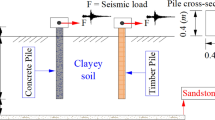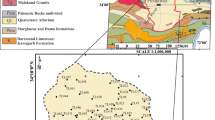Abstract
Peak ground acceleration (PGA) is one of the most important parameters in structural seismic design. Since many variables such as soil characteristics and attenuation relations are probabilistic parameters, the PGA cannot be determined using deterministic approaches. In this paper, by using the concept of reliability, effects of soil characteristics on PGA have been investigated for Kermanshah (Iran) as the case study. Several deterministic analyses were performed using the PLAXIS software, and the amplification factor of soil was obtained. From the obtained results an artificial neural network (ANN) was trained according to the input–output pairs and these emulators were used as an alternative for PLAXIS software. As the next step for effective parameters on PGA, a great number of input data according to the probability density function, average, and standard deviation were generated. According to these data, PGA was determined on the ground by using ANN, and reliability was calculated according to Monte Carlo simulation. In fact, reliability was calculated by comparing the PGA in deterministic and probabilistic approach. Finally, sensitivity analyses for the effect of soil characteristics on PGA were performed.











Similar content being viewed by others
References
Apostolidis P, Raptakisa D, Roumeliotib Z, Pitilakis K (2004) Determination of S-wave velocity structure using microtremors and spac method applied in Thessaloniki (Greece). Soil Dyn Earthq Eng 24:49–67
Baziar MH, Shrafi H, Roudsari TM, Habibi MR (2009) Using neural network for prediction of the dynamic period and amplification factor of soil for microzonation. J EJGE 14:Bund J
Bessaon B, Kaynia AM (2002) Site amplification in lava rock on soft sediments. Soil Dyn Earthq Eng 22:525–540
Choobbasti AJ, Tavakoli H, Kutanaei SS (2014) Modeling and optimization of a trench layer location around a pipeline using artificial neural networks and particle swarm optimization algorithm. Tunn Undergr Space Technol 40:192–202
El-Hussain I, Deif A, Al-Jabri K, Mohamed AM, El-Hady S, Al-Habsi Z (2013) Efficiency of horizontal-to-vertical spectral ratio (HVSR) in defining the fundamental frequency in Muscat Region. Sultanate of Oman: a comparative study. Arab J Geosci. doi:10.1007/s12517-013-0948-8
Fandi M, Alyazjeen T (2011) Variation of ground-motion amplification and structural dynamic characteristics of Amman citadel. Arab J Geosci 4:1351–1361
Fandi M, Alyazjeen T (2013) Evaluation of site amplification, structural dynamic characteristics, and structural vulnerability rating of the city of Aqaba. Arab J Geosci 6:1465–1478
Fiore VD (2010) Seismic site amplification induced by topographic irregularity: results of a numerical analysis on 2D synthetic models. Eng Geol 114:109–115
Garcia SR, Romo MP, Sarmiento N (2002) Modeling ground motion in Mexico City using artificial neural networks. Geofis Int 42:173–183
Hasancebi N, Ulusay R (2006) Evaluation of site amplification and site period using different methods for an earthquake-prone settlement in Western Turkey. Eng Geol 87:85–104
Hurtado JE, Londono JM, Meza MA (2001) On the applicability of neural networks for soil dynamic amplification analysis. Soil Dyn Earthq Eng 21:579–591
Irfan M, Emam M, Khan Z, Abdalla J (2012) Local site effects on seismic ground response of Dubai-Sharjah metropolitan area. GeoCongress ASCE 1869–1878
Kamatchi P, Ramana GV, Nagpal AK, Iyer NR (2013) Modelling propagation of stress waves through soil medium for ground response analysis. Engineering 5:611–621
Kerh T, Ting SB (2005) Neural network estimation of ground peak acceleration at stations along Taiwan high-speed rail system. Eng Appl Artif Intell 18:857–866
Khandelwal M, Singh TN (2011) Predicting elastic properties of schistose rocks from unconfined strength using intelligent approach. Arab J Geosci 4:435–442
Konno K, Ohmachi T (1998) Ground-motion characteristics estimated from spectral ratio between horizontal and vertical components of microtremor. Bull Seismol Soc Am 88:228–241
Kramer S (1996) Geotechnical earthquake engineering. Prentice Hall, New Jersey
Lachet C, Hatzfeld D, Bard PY, Theodulidis N, Papaioannou C, Savvaidis A (1996) Site effect and microzonation in the city of Thessaloniki (Greece): comparison of different approaches. Bull Seismol Soc Am 86:1692–1703
Lebrun B, Hatzfeld D, Bard Y (2001) Site effect study in urban areas: experimental results in Grenoble (France). Pure Appl Geophys 158:2543–2557
Majdeddin S, Hosseini MM, Pajouh MA (2012) Comparative study on the equivalent linear and the fully nonlinear site response analysis approaches. Arab J Geosci 5:587–597
Monjezi M, Bahrami A, Varjani AY, Sayadi AR (2011) Prediction and controlling of flyrock in blasting operation using artificial neural network. Arab J Geosci 4:421–425
Paolucci R, Colli P, Giacinto G (2002) Assessment of seismic site effects in 2-D alluvial valleys using neural networks. Earth Spectrom 16:661–680
Papadimitriou AG, Bouckovalas GD, Andrianopoulos KI (2014) Methodology for estimating seismic coefficients for performance-based design of earthdams and tall embankments. Soil Dyn Earthq Eng 56:57–73
Raghunandan ME (2012) Effect of soil layering on the ground response parameters. Nat Hazards 63:1115–1128
Rahman K, El-Aal A, El-Hady SM, Mohamed A, Moniem E (2012) Fundamental site frequency estimation at New Domiat city, Egypt. Arab J Geosci 5:653–661
Rezaei M, Monjezi M, Moghaddam SM, Farzaneh F (2011) Burden prediction in blasting operation using rock geomechanical properties. Arab J Geosci 5:1031–1037
Rezaei S, Choobbasti AJ, Kutanaei SS (2013) Site effect assessment using microtremor measurement, equivalent linear method, and artificial neural network (case study: Babol, Iran). Arab J Geosci. doi:10.1007/s12517-013-1201-1
Seed HB, Idriss IM (1982) Ground motions and soil liquifaction durig earthquake, EBRI Monograph, 21–57
Seed HB, Romo MP, Sun JI, Jaime A, Lysmer J (1988) The Mexico earthquake of September 19, 1985—relationships between soil conditions and earthquake ground motions. Earth Spectr 4:687–729
Tavakoli H, Omran OL, Kutanaei SS, Shiade MS (2014) Prediction of energy absorption capability in fiber reinforced self-compacting concrete containing nano-silica particles using artificial neural network. Lat Am J Solids Struct 11:966–979
Teramo A, Maugeri M, Bottari A, Termini D (2005) On a quick seismic microzonation of wide areas. Pure Appl Geophys 162(4):671–682
Tezcan S, Kaya E, Bal IE, Ozdemir Z (2002) Seismic amplification at Avcilar, Istanbul. Eng Struct 24:661–667
Tuladhar R (2002) Seismic microzonation of the Greater Bangkok with microtremor observations. Thesis for degree of Master of Engineering, Asian Institute of Technology, School of Civil Engineering
Tuladhar R, Yamazaki F, Warnitchai P, Saita J (2004) Seismic microzonation of the greater Bangkok area using microtremor observations. Earthq Eng Struct D 33:211–255
Werbos PJ (1974) Beyond regression: new tools for prediction and analysis in the behavioural sciences. Ph.D. Thesis, Harvard University
Ziemian L (2003) Hybrid neural network/finite-element modelling of wave propagation in infinite domains. Comput Struct 81:1099–1109
Author information
Authors and Affiliations
Corresponding author
Rights and permissions
About this article
Cite this article
Tavakoli, H., Soleimani Kutanaei, S. Evaluation of effect of soil characteristics on the seismic amplification factor using the neural network and reliability concept. Arab J Geosci 8, 3881–3891 (2015). https://doi.org/10.1007/s12517-014-1458-z
Received:
Accepted:
Published:
Issue Date:
DOI: https://doi.org/10.1007/s12517-014-1458-z




